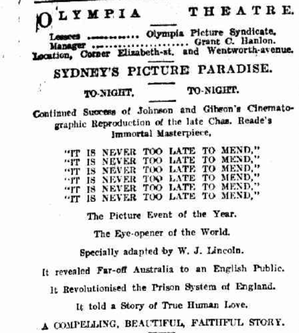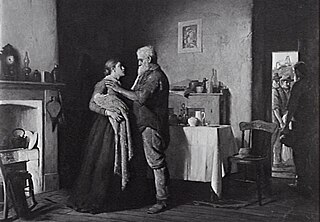Related Research Articles

William Joseph Lincoln was an Australian playwright, theatre manager, film director and screenwriter in the silent era. He produced, directed and/or wrote 23 films between 1911 and 1916.

John F. Gavin was a pioneer Australian film actor and director, one of the early filmmakers of the 1910s. He is best known for making films about bushrangers such as Captain Thunderbolt, Captain Moonlite, Ben Hall and Frank Gardiner. Known informally as 'Jack', Gavin worked in collaboration with his wife Agnes, who scripted many of his films.
Get-Rich-Quick Wallingford is a 1916 Australian silent comedy film directed by Fred Niblo. The film was the first made by the film unit of theatrical firm J. C. Williamson, although it was one of the last to be released. It was Niblo's debut film as a director and is considered a lost film.

Dawn is a 1928 British silent war film directed by Herbert Wilcox and starring Sybil Thorndike, Gordon Craig, and Marie Ault. It was produced by Wilcox for his British & Dominions Film Corporation. The film was made at Cricklewood Studios with sets designed by Clifford Pember.

The Martyrdom of Nurse Cavell is a 1916 Australian silent film about the execution of nurse Edith Cavell during World War I.

The Murder of Captain Fryatt is a 1917 Australian silent film about the execution of Captain Charles Fryatt during World War I from John and Agnes Gavin.

It Is Never Too Late to Mend is a 1911 Australian feature-length silent film written and directed by W. J. Lincoln.
The Mystery of the Hansom Cab is an Australian feature-length film directed by W. J. Lincoln based on the popular novel, which had also been adapted into a play. It was one of several films Lincoln made with the Tait family, who had produced The Story of the Kelly Gang.
Rip Van Winkle is a 1912 Australian feature-length film directed by W. J. Lincoln about Rip Van Winkle. It was arguably Australia's first fantasy film.
La Revanche, also known as The Vengeance, is a 1916 Australian feature-length film directed by W. J. Lincoln about the revenge sought by Belgian friends of Edith Cavell against the Germans during World War I. It was a sequel to Nurse Cavell (1916), using many of the same cast and crew.

The Life's Romance of Adam Lindsay Gordon is a 1916 Australian feature-length film directed by W. J. Lincoln, based on the life of poet Adam Lindsay Gordon.
The Reprieve is a 1913 Australian melodrama film directed by W. J. Lincoln about a man on trial for killing his unfaithful wife. It is considered a lost film. Contemporary reviews were positive.

Breaking the News is a 1912 Australian melodrama film directed by W. J. Lincoln based on John Longstaff's 1887 painting of the same name.
The Bells is a 1911 Australian feature-length silent film directed by W. J. Lincoln. It is based on the famous stage melodrama by Erckmann-Chatrian, adapted by Leopold Lewis, which in turn had been adapted for the Australian stage by W. J. Lincoln before he made it into a film.
Within Our Gates, also known as Deeds that Won Gallipoli, is a 1915 Australian silent film about Australia's fight with the German Empire and the Ottoman Empire during World War I, including the landing at Gaba Tepe during the Gallipoli campaign. The story was partly based on a play The Man Who Stayed at Home.
Charles Villiers was an Australian actor and occasional director who appeared in many silent films. According to a contemporary report, "there is probably no actor in Australia that has done more consistent picture work than Mr. Villiers, both as heavy lead, and director." He was particularly well known for playing villains.
Amalgamated Pictures Ltd was a film exchange company in Australia.
C. Post Mason, Charles Post Mason, real name Charles Post Doutney, was an American director, singer and manager. He was born in Vermont and then became a vaudeville singer. He moved to England and then in 1904 emigrated to Australia.
Robbery Under Arms is a 1907 Australian film based on the popular 1888 novel. It was from the team of J and N Tait and Millard Johnson and W Gibson, who had just made The Story of the Kelly Gang. It is considered a lost film.
Edith Cavell (1865–1915) was a WWI British nurse and martyr
References
- ↑ Copyright registration of film at National Archives of Australia
- ↑ "Advertising". The Brisbane Courier . 17 March 1916. p. 2. Retrieved 19 April 2012– via National Library of Australia.
- ↑ Mary Bateman, 'W. J. Lincoln', Cinema Papers, June–July 1980 p 214
- 1 2 3 "THE PICTURE SHOWS". Winner . Melbourne. 1 March 1916. p. 12. Retrieved 24 October 2014– via National Library of Australia.
- ↑ "PATHE'S PICTURES". The Ballarat Courier . Vic. 1 March 1916. p. 5 Edition: DAILY. Retrieved 19 April 2012– via National Library of Australia.
- ↑ "A HISTORICAL PICTURE". Warrnambool Standard . Vic. 4 March 1916. p. 2 Edition: DAILY. Retrieved 19 April 2012– via National Library of Australia.
- ↑ "THE PICTURE SHOWS". Winner . Melbourne. 23 February 1916. p. 10. Retrieved 24 October 2014– via National Library of Australia.
- 1 2 Marsden, Ralph. 'The Old Tin Shed in Exhibition Street': The J. C. Williamson Studio, Melbourne's Forgotten Film Factory [online]. Metro Magazine: Media & Education Magazine, No. 157, 2008: 144-153. Availability: <http://search.informit.com.au/documentSummary;dn=519108300276483;res=IELAPA> ISSN 0312-2654. [cited 15 Nov 14].
- ↑ "STAR PICTURES". Daily Herald . Adelaide. 29 March 1916. p. 2. Retrieved 24 October 2014– via National Library of Australia.
- ↑ "Advertising". Cairns Post (Qld. : 1909–1954) . Qld. 5 April 1916. p. 1. Retrieved 24 October 2014– via National Library of Australia.
- ↑ Andrew Pike and Ross Cooper, Australian Film 1900–1977: A Guide to Feature Film Production, Melbourne: Oxford University Press, 1998, p60
- ↑ "CINEMA PICTURES". Winner . Melbourne. 8 March 1916. p. 12. Retrieved 24 October 2014– via National Library of Australia.